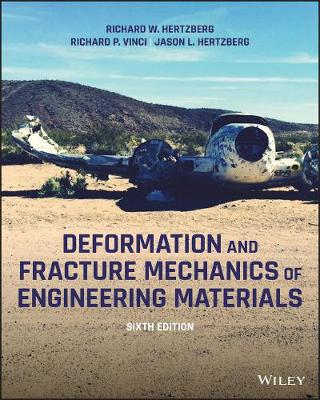Deformation and Fracture Mechanics of Engineering Materials
 -15%
portes grátis
-15%
portes grátis
Deformation and Fracture Mechanics of Engineering Materials
Vinci, Richard P.; Hertzberg, Richard W.; Hertzberg, Jason L.
John Wiley & Sons Inc
03/2021
800
Mole
Inglês
9781119670575
15 a 20 dias
1430
Descrição não disponível.
Foreword xvii
Preface to the Sixth Edition xix
The Comet and Titanic Disasters: Fiction Foreshadows Truth ! xix
Additional References for Video Entitled "The Comet and Titanic Disasters: Fiction Foreshadows Truth!!" xix
Stress Intensity Factor Formulations xx
Elliptical and Penny-Shaped Stress Intensity Factors xx
Multiplicity of Y-calibration Factors xx
Design Concepts xx
Estimation of Crack Tip Plastic Zone Size and Shear Lip Development xx
Compact-Tension Fracture Toughness Test xx
Fatigue Fracture xxi
Extensive Folder of Powerpoint Slides xxii
Chapter Thirteen: Final Thoughts xxii
Dedication xxii
Acknowledgments xxii
About the Authors xxv
Section One Recoverable and Nonrecoverable Deformation 1
Chapter 1 Elastic Response of Solids 3
1.1 Mechanical Testing 3
1.2 Definitions of Stress and Strain 4
1.3 Stress-Strain Curves for Uniaxial Loading 8
1.4 Nonaxial Testing 23
1.5 Multiaxial Linear Elastic Response 27
1.6 Elastic Anisotropy 34
1.7 Thermal Stresses and Thermal Shock-Induced Failure 50
Chapter 2 Yielding and Plastic Flow 63
2.1 Dislocations in Metals and Ceramics 63
2.2 Slip 81
2.3 Yield Criteria for Metals and Ceramics 88
2.4 Post-Yield Plastic Deformation 90
2.5 Slip in Single Crystals and Textured Materials 102
2.6 Deformation Twinning 111
2.7 Plasticity in Polymers 120
Chapter 3 Controlling Strength 143
3.1 Strengthening: A Definition 143
3.2 Strengthening of Metals 143
3.3 Strain (Work) Hardening 151
3.4 Boundary Strengthening 155
3.5 Solid Solution Strengthening 158
3.6 Precipitation Hardening 164
3.7 Dispersion Strengthening 170
3.8 Strengthening of Steel Alloys by Multiple Mechanisms 172
3.9 Metal-Matrix Composite Strengthening 175
3.10 Strengthening of Polymers 177
3.11 Polymer-Matrix Composites 182
Chapter 4 Time-Dependent Deformation 189
4.1 Time-Dependent Mechanical Behavior of Solids 189
4.2 Creep of Crystalline Solids: An Overview 191
4.3 Temperature-Stress-Strain-Rate Relations 195
4.4 Deformation Mechanisms 202
4.5 Superplasticity 205
4.6 Deformation-Mechanism Maps 208
4.7 Parametric Relations: Extrapolation Procedures for Creep Rupture Data 215
4.8 Materials for Elevated Temperature Use 220
4.9 Viscoelastic Response of Polymers and the Role of Structure 227
Section Two Fracture Mechanics of Engineering Materials 249
Chapter 5 Fracture: An Overview 251
5.1 Introduction 251
5.2 Theoretical Cohesive Strength 253
5.3 Defect Population in Solids 254
5.4 The Stress-Concentration Factor 260
5.5 Notch Strengthening 264
5.6 External Variables Affecting Fracture 265
5.7 Characterizing the Fracture Process 266
5.8 Macroscopic Fracture Characteristics 269
5.9 Microscopic Fracture Mechanisms 278
Chapter 6 Elements of Fracture Mechanics 299
6.1 Griffith Crack Theory 299
6.2 Charpy Impact Fracture Testing 307
6.3 Related Polymer Fracture Test Methods 311
6.4 Limitations of the Transition Temperature Philosophy 312
6.5 Stress Analysis of Cracks 315
FAILURE ANALYSIS CASE STUDY 6.1: Fracture Toughness of Manatee Bones in Impact 327
6.6 Design Philosophy 328
6.7 Relation Between Energy Rate and Stress Field Approaches 330
6.8 Crack-Tip Plastic-Zone Size Estimation 332
6.9 Fracture-Mode Transition: Plane Stress Versus Plane Strain 336
FAILURE ANALYSIS CASE STUDY 6.2: Analysis of Crack Development during Structural Fatigue Test 339
6.10 Plane-Strain Fracture-Toughness Testing of Metals and Ceramics 341
6.11 Fracture Toughness of Engineering Alloys 344
6.12 Plane-Stress Fracture-Toughness Testing 355
6.13 Toughness Determination from Crack-Opening Displacement Measurement 358
6.14 Fracture-Toughness Determination and Elastic-Plastic Analysis with the J Integral 360
6.14.1 Determination of JIC 362
6.15 Other Fracture Models 368
6.16 Fracture Mechanics and Adhesion Measurements 371
Chapter 7 Fracture Toughness 383
7.1 Some Useful Generalities 383
7.2 Intrinsic Toughness of Metals and Alloys 389
7.3 Toughening of Metals and Alloys Through Microstructural Anisotropy 402
7.4 Optimizing Toughness of Specific Alloy Systems 411
7.5 Toughness of Ceramics, Glasses, and Their Composites 416
7.6 Toughness of Polymers and Polymer-Matrix Composites 426
7.7 Natural and Biomimetic Materials 434
7.8 Metallurgical Embrittlement of Ferrous Alloys 440
7.9 Additional Data 449
Chapter 8 Environment-Assisted Cracking 463
8.1 Embrittlement Models 465
8.2 Fracture Mechanics Test Methods 472
8.3 Life and Crack-Length Calculations 492
Chapter 9 Cyclic Stress and Strain Fatigue 499
9.1 Macrofractography of Fatigue Failures 499
9.2 Cyclic Stress-Controlled Fatigue 503
9.3 Cyclic Strain-Controlled Fatigue 529
9.4 Fatigue Life Estimations for Notched Components 541
9.5 Fatigue Crack Initiation Mechanisms 545
9.6 Avoidance of Fatigue Damage 547
Chapter 10 Fatigue Crack Propagation 559
10.1 Stress and Crack Length Correlations with FCP 559
10.2 Macroscopic Fracture Modes in Fatigue 568
FATIGUE FAILURE ANALYSIS CASE STUDY 10.1: Stress Intensity Factor Estimate Based on Fatigue Growth Bands 571
10.3 Microscopic Fracture Mechanisms 572
10.4 Crack Growth Behavior at ?K Extremes 578
10.5 Influence of Load Interactions 592
10.6 Environmentally Enhanced FCP (Corrosion Fatigue) 600
10.7 Microstructural Aspects of FCP in Metal Alloys 606
10.8 Fatigue Crack Propagation in Engineering Plastics 618
10.9 Fatigue Crack Propagation in Ceramics 628
10.10 Fatigue Crack Propagation in Composites 632
Chapter 11 Analyses of Engineering Failures 645
11.1 Typical Defects 647
11.2 Macroscopic Fracture Surface Examination 647
11.3 Metallographic and Fractographic Examination 651
11.4 Component Failure Analysis Data 652
11.5 Case Histories 652
CASE 1: Shotgun Barrel Failures 653
CASE 2: Analysis of Aileron Power Control Cylinder Service Failure 658
CASE 3: Failure of Pittsburgh Station Generator Rotor Forging 660
CASE 4: Stress Corrosion Cracking Failure of the Point Pleasant Bridge 661
CASE 5: Weld Cold Crack-Induced Failure of Kings Bridge, Melbourne, Australia 664
CASE 6: Failure Analysis of 175-mm Gun Tube 665
CASE 7: Hydrotest Failure of a 660-cm-Diameter Rocket Motor Casing 670
CASE 8: Premature Fracture of Powder-Pressing Die 673
CASE 9: A Laboratory Analysis of a Lavatory Failure 674
11.6 Additional Comments Regarding Welded Bridges 676
Chapter 12 Consequences of Product Failure 683
12.1 Introduction to Product Liability 683
12.2 History of Product Liability 684
12.3 Product Recall 697
RECALL CASE STUDY: The "Unstable" Ladder 708
Chapter 13 Final Thoughts 713
13.1 Funding Highway and Bridge Repairs 713
13.2 Nonredundant Bridges 715
13.3 Dee Bridge Collapse, Chester, England (1847) 716
13.4 A Final Reflection 718
Appendix A Fracture Surface Preservation, Cleaning and Replication Techniques, and Image Interpretation 721
A.1 Fracture Surface Preservation 721
A.2 Fracture Surface Cleaning 721
A.3 Replica Preparation and Image Interpretation 723
Appendix B K Calibrations for Typical Fracture Toughness and Fatigue Crack Propagation Test Specimens 727
Appendix C Y Calibration Factors for Elliptical and Semicircular Surface Flaws 731
Appendix D Suggested Checklist of Data Desirable for Complete Failure Analysis 733
Author Index 737
Materials Index 749
Subject Index 755
Preface to the Sixth Edition xix
The Comet and Titanic Disasters: Fiction Foreshadows Truth ! xix
Additional References for Video Entitled "The Comet and Titanic Disasters: Fiction Foreshadows Truth!!" xix
Stress Intensity Factor Formulations xx
Elliptical and Penny-Shaped Stress Intensity Factors xx
Multiplicity of Y-calibration Factors xx
Design Concepts xx
Estimation of Crack Tip Plastic Zone Size and Shear Lip Development xx
Compact-Tension Fracture Toughness Test xx
Fatigue Fracture xxi
Extensive Folder of Powerpoint Slides xxii
Chapter Thirteen: Final Thoughts xxii
Dedication xxii
Acknowledgments xxii
About the Authors xxv
Section One Recoverable and Nonrecoverable Deformation 1
Chapter 1 Elastic Response of Solids 3
1.1 Mechanical Testing 3
1.2 Definitions of Stress and Strain 4
1.3 Stress-Strain Curves for Uniaxial Loading 8
1.4 Nonaxial Testing 23
1.5 Multiaxial Linear Elastic Response 27
1.6 Elastic Anisotropy 34
1.7 Thermal Stresses and Thermal Shock-Induced Failure 50
Chapter 2 Yielding and Plastic Flow 63
2.1 Dislocations in Metals and Ceramics 63
2.2 Slip 81
2.3 Yield Criteria for Metals and Ceramics 88
2.4 Post-Yield Plastic Deformation 90
2.5 Slip in Single Crystals and Textured Materials 102
2.6 Deformation Twinning 111
2.7 Plasticity in Polymers 120
Chapter 3 Controlling Strength 143
3.1 Strengthening: A Definition 143
3.2 Strengthening of Metals 143
3.3 Strain (Work) Hardening 151
3.4 Boundary Strengthening 155
3.5 Solid Solution Strengthening 158
3.6 Precipitation Hardening 164
3.7 Dispersion Strengthening 170
3.8 Strengthening of Steel Alloys by Multiple Mechanisms 172
3.9 Metal-Matrix Composite Strengthening 175
3.10 Strengthening of Polymers 177
3.11 Polymer-Matrix Composites 182
Chapter 4 Time-Dependent Deformation 189
4.1 Time-Dependent Mechanical Behavior of Solids 189
4.2 Creep of Crystalline Solids: An Overview 191
4.3 Temperature-Stress-Strain-Rate Relations 195
4.4 Deformation Mechanisms 202
4.5 Superplasticity 205
4.6 Deformation-Mechanism Maps 208
4.7 Parametric Relations: Extrapolation Procedures for Creep Rupture Data 215
4.8 Materials for Elevated Temperature Use 220
4.9 Viscoelastic Response of Polymers and the Role of Structure 227
Section Two Fracture Mechanics of Engineering Materials 249
Chapter 5 Fracture: An Overview 251
5.1 Introduction 251
5.2 Theoretical Cohesive Strength 253
5.3 Defect Population in Solids 254
5.4 The Stress-Concentration Factor 260
5.5 Notch Strengthening 264
5.6 External Variables Affecting Fracture 265
5.7 Characterizing the Fracture Process 266
5.8 Macroscopic Fracture Characteristics 269
5.9 Microscopic Fracture Mechanisms 278
Chapter 6 Elements of Fracture Mechanics 299
6.1 Griffith Crack Theory 299
6.2 Charpy Impact Fracture Testing 307
6.3 Related Polymer Fracture Test Methods 311
6.4 Limitations of the Transition Temperature Philosophy 312
6.5 Stress Analysis of Cracks 315
FAILURE ANALYSIS CASE STUDY 6.1: Fracture Toughness of Manatee Bones in Impact 327
6.6 Design Philosophy 328
6.7 Relation Between Energy Rate and Stress Field Approaches 330
6.8 Crack-Tip Plastic-Zone Size Estimation 332
6.9 Fracture-Mode Transition: Plane Stress Versus Plane Strain 336
FAILURE ANALYSIS CASE STUDY 6.2: Analysis of Crack Development during Structural Fatigue Test 339
6.10 Plane-Strain Fracture-Toughness Testing of Metals and Ceramics 341
6.11 Fracture Toughness of Engineering Alloys 344
6.12 Plane-Stress Fracture-Toughness Testing 355
6.13 Toughness Determination from Crack-Opening Displacement Measurement 358
6.14 Fracture-Toughness Determination and Elastic-Plastic Analysis with the J Integral 360
6.14.1 Determination of JIC 362
6.15 Other Fracture Models 368
6.16 Fracture Mechanics and Adhesion Measurements 371
Chapter 7 Fracture Toughness 383
7.1 Some Useful Generalities 383
7.2 Intrinsic Toughness of Metals and Alloys 389
7.3 Toughening of Metals and Alloys Through Microstructural Anisotropy 402
7.4 Optimizing Toughness of Specific Alloy Systems 411
7.5 Toughness of Ceramics, Glasses, and Their Composites 416
7.6 Toughness of Polymers and Polymer-Matrix Composites 426
7.7 Natural and Biomimetic Materials 434
7.8 Metallurgical Embrittlement of Ferrous Alloys 440
7.9 Additional Data 449
Chapter 8 Environment-Assisted Cracking 463
8.1 Embrittlement Models 465
8.2 Fracture Mechanics Test Methods 472
8.3 Life and Crack-Length Calculations 492
Chapter 9 Cyclic Stress and Strain Fatigue 499
9.1 Macrofractography of Fatigue Failures 499
9.2 Cyclic Stress-Controlled Fatigue 503
9.3 Cyclic Strain-Controlled Fatigue 529
9.4 Fatigue Life Estimations for Notched Components 541
9.5 Fatigue Crack Initiation Mechanisms 545
9.6 Avoidance of Fatigue Damage 547
Chapter 10 Fatigue Crack Propagation 559
10.1 Stress and Crack Length Correlations with FCP 559
10.2 Macroscopic Fracture Modes in Fatigue 568
FATIGUE FAILURE ANALYSIS CASE STUDY 10.1: Stress Intensity Factor Estimate Based on Fatigue Growth Bands 571
10.3 Microscopic Fracture Mechanisms 572
10.4 Crack Growth Behavior at ?K Extremes 578
10.5 Influence of Load Interactions 592
10.6 Environmentally Enhanced FCP (Corrosion Fatigue) 600
10.7 Microstructural Aspects of FCP in Metal Alloys 606
10.8 Fatigue Crack Propagation in Engineering Plastics 618
10.9 Fatigue Crack Propagation in Ceramics 628
10.10 Fatigue Crack Propagation in Composites 632
Chapter 11 Analyses of Engineering Failures 645
11.1 Typical Defects 647
11.2 Macroscopic Fracture Surface Examination 647
11.3 Metallographic and Fractographic Examination 651
11.4 Component Failure Analysis Data 652
11.5 Case Histories 652
CASE 1: Shotgun Barrel Failures 653
CASE 2: Analysis of Aileron Power Control Cylinder Service Failure 658
CASE 3: Failure of Pittsburgh Station Generator Rotor Forging 660
CASE 4: Stress Corrosion Cracking Failure of the Point Pleasant Bridge 661
CASE 5: Weld Cold Crack-Induced Failure of Kings Bridge, Melbourne, Australia 664
CASE 6: Failure Analysis of 175-mm Gun Tube 665
CASE 7: Hydrotest Failure of a 660-cm-Diameter Rocket Motor Casing 670
CASE 8: Premature Fracture of Powder-Pressing Die 673
CASE 9: A Laboratory Analysis of a Lavatory Failure 674
11.6 Additional Comments Regarding Welded Bridges 676
Chapter 12 Consequences of Product Failure 683
12.1 Introduction to Product Liability 683
12.2 History of Product Liability 684
12.3 Product Recall 697
RECALL CASE STUDY: The "Unstable" Ladder 708
Chapter 13 Final Thoughts 713
13.1 Funding Highway and Bridge Repairs 713
13.2 Nonredundant Bridges 715
13.3 Dee Bridge Collapse, Chester, England (1847) 716
13.4 A Final Reflection 718
Appendix A Fracture Surface Preservation, Cleaning and Replication Techniques, and Image Interpretation 721
A.1 Fracture Surface Preservation 721
A.2 Fracture Surface Cleaning 721
A.3 Replica Preparation and Image Interpretation 723
Appendix B K Calibrations for Typical Fracture Toughness and Fatigue Crack Propagation Test Specimens 727
Appendix C Y Calibration Factors for Elliptical and Semicircular Surface Flaws 731
Appendix D Suggested Checklist of Data Desirable for Complete Failure Analysis 733
Author Index 737
Materials Index 749
Subject Index 755
Este título pertence ao(s) assunto(s) indicados(s). Para ver outros títulos clique no assunto desejado.
fracture mechanics textbook; materials science textbook; deformation of solids; fracture mechanics of solids; engineering materials fracture mechanics; engineering failure analysis; product failure analysis; engineering fracture case studies
Foreword xvii
Preface to the Sixth Edition xix
The Comet and Titanic Disasters: Fiction Foreshadows Truth ! xix
Additional References for Video Entitled "The Comet and Titanic Disasters: Fiction Foreshadows Truth!!" xix
Stress Intensity Factor Formulations xx
Elliptical and Penny-Shaped Stress Intensity Factors xx
Multiplicity of Y-calibration Factors xx
Design Concepts xx
Estimation of Crack Tip Plastic Zone Size and Shear Lip Development xx
Compact-Tension Fracture Toughness Test xx
Fatigue Fracture xxi
Extensive Folder of Powerpoint Slides xxii
Chapter Thirteen: Final Thoughts xxii
Dedication xxii
Acknowledgments xxii
About the Authors xxv
Section One Recoverable and Nonrecoverable Deformation 1
Chapter 1 Elastic Response of Solids 3
1.1 Mechanical Testing 3
1.2 Definitions of Stress and Strain 4
1.3 Stress-Strain Curves for Uniaxial Loading 8
1.4 Nonaxial Testing 23
1.5 Multiaxial Linear Elastic Response 27
1.6 Elastic Anisotropy 34
1.7 Thermal Stresses and Thermal Shock-Induced Failure 50
Chapter 2 Yielding and Plastic Flow 63
2.1 Dislocations in Metals and Ceramics 63
2.2 Slip 81
2.3 Yield Criteria for Metals and Ceramics 88
2.4 Post-Yield Plastic Deformation 90
2.5 Slip in Single Crystals and Textured Materials 102
2.6 Deformation Twinning 111
2.7 Plasticity in Polymers 120
Chapter 3 Controlling Strength 143
3.1 Strengthening: A Definition 143
3.2 Strengthening of Metals 143
3.3 Strain (Work) Hardening 151
3.4 Boundary Strengthening 155
3.5 Solid Solution Strengthening 158
3.6 Precipitation Hardening 164
3.7 Dispersion Strengthening 170
3.8 Strengthening of Steel Alloys by Multiple Mechanisms 172
3.9 Metal-Matrix Composite Strengthening 175
3.10 Strengthening of Polymers 177
3.11 Polymer-Matrix Composites 182
Chapter 4 Time-Dependent Deformation 189
4.1 Time-Dependent Mechanical Behavior of Solids 189
4.2 Creep of Crystalline Solids: An Overview 191
4.3 Temperature-Stress-Strain-Rate Relations 195
4.4 Deformation Mechanisms 202
4.5 Superplasticity 205
4.6 Deformation-Mechanism Maps 208
4.7 Parametric Relations: Extrapolation Procedures for Creep Rupture Data 215
4.8 Materials for Elevated Temperature Use 220
4.9 Viscoelastic Response of Polymers and the Role of Structure 227
Section Two Fracture Mechanics of Engineering Materials 249
Chapter 5 Fracture: An Overview 251
5.1 Introduction 251
5.2 Theoretical Cohesive Strength 253
5.3 Defect Population in Solids 254
5.4 The Stress-Concentration Factor 260
5.5 Notch Strengthening 264
5.6 External Variables Affecting Fracture 265
5.7 Characterizing the Fracture Process 266
5.8 Macroscopic Fracture Characteristics 269
5.9 Microscopic Fracture Mechanisms 278
Chapter 6 Elements of Fracture Mechanics 299
6.1 Griffith Crack Theory 299
6.2 Charpy Impact Fracture Testing 307
6.3 Related Polymer Fracture Test Methods 311
6.4 Limitations of the Transition Temperature Philosophy 312
6.5 Stress Analysis of Cracks 315
FAILURE ANALYSIS CASE STUDY 6.1: Fracture Toughness of Manatee Bones in Impact 327
6.6 Design Philosophy 328
6.7 Relation Between Energy Rate and Stress Field Approaches 330
6.8 Crack-Tip Plastic-Zone Size Estimation 332
6.9 Fracture-Mode Transition: Plane Stress Versus Plane Strain 336
FAILURE ANALYSIS CASE STUDY 6.2: Analysis of Crack Development during Structural Fatigue Test 339
6.10 Plane-Strain Fracture-Toughness Testing of Metals and Ceramics 341
6.11 Fracture Toughness of Engineering Alloys 344
6.12 Plane-Stress Fracture-Toughness Testing 355
6.13 Toughness Determination from Crack-Opening Displacement Measurement 358
6.14 Fracture-Toughness Determination and Elastic-Plastic Analysis with the J Integral 360
6.14.1 Determination of JIC 362
6.15 Other Fracture Models 368
6.16 Fracture Mechanics and Adhesion Measurements 371
Chapter 7 Fracture Toughness 383
7.1 Some Useful Generalities 383
7.2 Intrinsic Toughness of Metals and Alloys 389
7.3 Toughening of Metals and Alloys Through Microstructural Anisotropy 402
7.4 Optimizing Toughness of Specific Alloy Systems 411
7.5 Toughness of Ceramics, Glasses, and Their Composites 416
7.6 Toughness of Polymers and Polymer-Matrix Composites 426
7.7 Natural and Biomimetic Materials 434
7.8 Metallurgical Embrittlement of Ferrous Alloys 440
7.9 Additional Data 449
Chapter 8 Environment-Assisted Cracking 463
8.1 Embrittlement Models 465
8.2 Fracture Mechanics Test Methods 472
8.3 Life and Crack-Length Calculations 492
Chapter 9 Cyclic Stress and Strain Fatigue 499
9.1 Macrofractography of Fatigue Failures 499
9.2 Cyclic Stress-Controlled Fatigue 503
9.3 Cyclic Strain-Controlled Fatigue 529
9.4 Fatigue Life Estimations for Notched Components 541
9.5 Fatigue Crack Initiation Mechanisms 545
9.6 Avoidance of Fatigue Damage 547
Chapter 10 Fatigue Crack Propagation 559
10.1 Stress and Crack Length Correlations with FCP 559
10.2 Macroscopic Fracture Modes in Fatigue 568
FATIGUE FAILURE ANALYSIS CASE STUDY 10.1: Stress Intensity Factor Estimate Based on Fatigue Growth Bands 571
10.3 Microscopic Fracture Mechanisms 572
10.4 Crack Growth Behavior at ?K Extremes 578
10.5 Influence of Load Interactions 592
10.6 Environmentally Enhanced FCP (Corrosion Fatigue) 600
10.7 Microstructural Aspects of FCP in Metal Alloys 606
10.8 Fatigue Crack Propagation in Engineering Plastics 618
10.9 Fatigue Crack Propagation in Ceramics 628
10.10 Fatigue Crack Propagation in Composites 632
Chapter 11 Analyses of Engineering Failures 645
11.1 Typical Defects 647
11.2 Macroscopic Fracture Surface Examination 647
11.3 Metallographic and Fractographic Examination 651
11.4 Component Failure Analysis Data 652
11.5 Case Histories 652
CASE 1: Shotgun Barrel Failures 653
CASE 2: Analysis of Aileron Power Control Cylinder Service Failure 658
CASE 3: Failure of Pittsburgh Station Generator Rotor Forging 660
CASE 4: Stress Corrosion Cracking Failure of the Point Pleasant Bridge 661
CASE 5: Weld Cold Crack-Induced Failure of Kings Bridge, Melbourne, Australia 664
CASE 6: Failure Analysis of 175-mm Gun Tube 665
CASE 7: Hydrotest Failure of a 660-cm-Diameter Rocket Motor Casing 670
CASE 8: Premature Fracture of Powder-Pressing Die 673
CASE 9: A Laboratory Analysis of a Lavatory Failure 674
11.6 Additional Comments Regarding Welded Bridges 676
Chapter 12 Consequences of Product Failure 683
12.1 Introduction to Product Liability 683
12.2 History of Product Liability 684
12.3 Product Recall 697
RECALL CASE STUDY: The "Unstable" Ladder 708
Chapter 13 Final Thoughts 713
13.1 Funding Highway and Bridge Repairs 713
13.2 Nonredundant Bridges 715
13.3 Dee Bridge Collapse, Chester, England (1847) 716
13.4 A Final Reflection 718
Appendix A Fracture Surface Preservation, Cleaning and Replication Techniques, and Image Interpretation 721
A.1 Fracture Surface Preservation 721
A.2 Fracture Surface Cleaning 721
A.3 Replica Preparation and Image Interpretation 723
Appendix B K Calibrations for Typical Fracture Toughness and Fatigue Crack Propagation Test Specimens 727
Appendix C Y Calibration Factors for Elliptical and Semicircular Surface Flaws 731
Appendix D Suggested Checklist of Data Desirable for Complete Failure Analysis 733
Author Index 737
Materials Index 749
Subject Index 755
Preface to the Sixth Edition xix
The Comet and Titanic Disasters: Fiction Foreshadows Truth ! xix
Additional References for Video Entitled "The Comet and Titanic Disasters: Fiction Foreshadows Truth!!" xix
Stress Intensity Factor Formulations xx
Elliptical and Penny-Shaped Stress Intensity Factors xx
Multiplicity of Y-calibration Factors xx
Design Concepts xx
Estimation of Crack Tip Plastic Zone Size and Shear Lip Development xx
Compact-Tension Fracture Toughness Test xx
Fatigue Fracture xxi
Extensive Folder of Powerpoint Slides xxii
Chapter Thirteen: Final Thoughts xxii
Dedication xxii
Acknowledgments xxii
About the Authors xxv
Section One Recoverable and Nonrecoverable Deformation 1
Chapter 1 Elastic Response of Solids 3
1.1 Mechanical Testing 3
1.2 Definitions of Stress and Strain 4
1.3 Stress-Strain Curves for Uniaxial Loading 8
1.4 Nonaxial Testing 23
1.5 Multiaxial Linear Elastic Response 27
1.6 Elastic Anisotropy 34
1.7 Thermal Stresses and Thermal Shock-Induced Failure 50
Chapter 2 Yielding and Plastic Flow 63
2.1 Dislocations in Metals and Ceramics 63
2.2 Slip 81
2.3 Yield Criteria for Metals and Ceramics 88
2.4 Post-Yield Plastic Deformation 90
2.5 Slip in Single Crystals and Textured Materials 102
2.6 Deformation Twinning 111
2.7 Plasticity in Polymers 120
Chapter 3 Controlling Strength 143
3.1 Strengthening: A Definition 143
3.2 Strengthening of Metals 143
3.3 Strain (Work) Hardening 151
3.4 Boundary Strengthening 155
3.5 Solid Solution Strengthening 158
3.6 Precipitation Hardening 164
3.7 Dispersion Strengthening 170
3.8 Strengthening of Steel Alloys by Multiple Mechanisms 172
3.9 Metal-Matrix Composite Strengthening 175
3.10 Strengthening of Polymers 177
3.11 Polymer-Matrix Composites 182
Chapter 4 Time-Dependent Deformation 189
4.1 Time-Dependent Mechanical Behavior of Solids 189
4.2 Creep of Crystalline Solids: An Overview 191
4.3 Temperature-Stress-Strain-Rate Relations 195
4.4 Deformation Mechanisms 202
4.5 Superplasticity 205
4.6 Deformation-Mechanism Maps 208
4.7 Parametric Relations: Extrapolation Procedures for Creep Rupture Data 215
4.8 Materials for Elevated Temperature Use 220
4.9 Viscoelastic Response of Polymers and the Role of Structure 227
Section Two Fracture Mechanics of Engineering Materials 249
Chapter 5 Fracture: An Overview 251
5.1 Introduction 251
5.2 Theoretical Cohesive Strength 253
5.3 Defect Population in Solids 254
5.4 The Stress-Concentration Factor 260
5.5 Notch Strengthening 264
5.6 External Variables Affecting Fracture 265
5.7 Characterizing the Fracture Process 266
5.8 Macroscopic Fracture Characteristics 269
5.9 Microscopic Fracture Mechanisms 278
Chapter 6 Elements of Fracture Mechanics 299
6.1 Griffith Crack Theory 299
6.2 Charpy Impact Fracture Testing 307
6.3 Related Polymer Fracture Test Methods 311
6.4 Limitations of the Transition Temperature Philosophy 312
6.5 Stress Analysis of Cracks 315
FAILURE ANALYSIS CASE STUDY 6.1: Fracture Toughness of Manatee Bones in Impact 327
6.6 Design Philosophy 328
6.7 Relation Between Energy Rate and Stress Field Approaches 330
6.8 Crack-Tip Plastic-Zone Size Estimation 332
6.9 Fracture-Mode Transition: Plane Stress Versus Plane Strain 336
FAILURE ANALYSIS CASE STUDY 6.2: Analysis of Crack Development during Structural Fatigue Test 339
6.10 Plane-Strain Fracture-Toughness Testing of Metals and Ceramics 341
6.11 Fracture Toughness of Engineering Alloys 344
6.12 Plane-Stress Fracture-Toughness Testing 355
6.13 Toughness Determination from Crack-Opening Displacement Measurement 358
6.14 Fracture-Toughness Determination and Elastic-Plastic Analysis with the J Integral 360
6.14.1 Determination of JIC 362
6.15 Other Fracture Models 368
6.16 Fracture Mechanics and Adhesion Measurements 371
Chapter 7 Fracture Toughness 383
7.1 Some Useful Generalities 383
7.2 Intrinsic Toughness of Metals and Alloys 389
7.3 Toughening of Metals and Alloys Through Microstructural Anisotropy 402
7.4 Optimizing Toughness of Specific Alloy Systems 411
7.5 Toughness of Ceramics, Glasses, and Their Composites 416
7.6 Toughness of Polymers and Polymer-Matrix Composites 426
7.7 Natural and Biomimetic Materials 434
7.8 Metallurgical Embrittlement of Ferrous Alloys 440
7.9 Additional Data 449
Chapter 8 Environment-Assisted Cracking 463
8.1 Embrittlement Models 465
8.2 Fracture Mechanics Test Methods 472
8.3 Life and Crack-Length Calculations 492
Chapter 9 Cyclic Stress and Strain Fatigue 499
9.1 Macrofractography of Fatigue Failures 499
9.2 Cyclic Stress-Controlled Fatigue 503
9.3 Cyclic Strain-Controlled Fatigue 529
9.4 Fatigue Life Estimations for Notched Components 541
9.5 Fatigue Crack Initiation Mechanisms 545
9.6 Avoidance of Fatigue Damage 547
Chapter 10 Fatigue Crack Propagation 559
10.1 Stress and Crack Length Correlations with FCP 559
10.2 Macroscopic Fracture Modes in Fatigue 568
FATIGUE FAILURE ANALYSIS CASE STUDY 10.1: Stress Intensity Factor Estimate Based on Fatigue Growth Bands 571
10.3 Microscopic Fracture Mechanisms 572
10.4 Crack Growth Behavior at ?K Extremes 578
10.5 Influence of Load Interactions 592
10.6 Environmentally Enhanced FCP (Corrosion Fatigue) 600
10.7 Microstructural Aspects of FCP in Metal Alloys 606
10.8 Fatigue Crack Propagation in Engineering Plastics 618
10.9 Fatigue Crack Propagation in Ceramics 628
10.10 Fatigue Crack Propagation in Composites 632
Chapter 11 Analyses of Engineering Failures 645
11.1 Typical Defects 647
11.2 Macroscopic Fracture Surface Examination 647
11.3 Metallographic and Fractographic Examination 651
11.4 Component Failure Analysis Data 652
11.5 Case Histories 652
CASE 1: Shotgun Barrel Failures 653
CASE 2: Analysis of Aileron Power Control Cylinder Service Failure 658
CASE 3: Failure of Pittsburgh Station Generator Rotor Forging 660
CASE 4: Stress Corrosion Cracking Failure of the Point Pleasant Bridge 661
CASE 5: Weld Cold Crack-Induced Failure of Kings Bridge, Melbourne, Australia 664
CASE 6: Failure Analysis of 175-mm Gun Tube 665
CASE 7: Hydrotest Failure of a 660-cm-Diameter Rocket Motor Casing 670
CASE 8: Premature Fracture of Powder-Pressing Die 673
CASE 9: A Laboratory Analysis of a Lavatory Failure 674
11.6 Additional Comments Regarding Welded Bridges 676
Chapter 12 Consequences of Product Failure 683
12.1 Introduction to Product Liability 683
12.2 History of Product Liability 684
12.3 Product Recall 697
RECALL CASE STUDY: The "Unstable" Ladder 708
Chapter 13 Final Thoughts 713
13.1 Funding Highway and Bridge Repairs 713
13.2 Nonredundant Bridges 715
13.3 Dee Bridge Collapse, Chester, England (1847) 716
13.4 A Final Reflection 718
Appendix A Fracture Surface Preservation, Cleaning and Replication Techniques, and Image Interpretation 721
A.1 Fracture Surface Preservation 721
A.2 Fracture Surface Cleaning 721
A.3 Replica Preparation and Image Interpretation 723
Appendix B K Calibrations for Typical Fracture Toughness and Fatigue Crack Propagation Test Specimens 727
Appendix C Y Calibration Factors for Elliptical and Semicircular Surface Flaws 731
Appendix D Suggested Checklist of Data Desirable for Complete Failure Analysis 733
Author Index 737
Materials Index 749
Subject Index 755
Este título pertence ao(s) assunto(s) indicados(s). Para ver outros títulos clique no assunto desejado.







